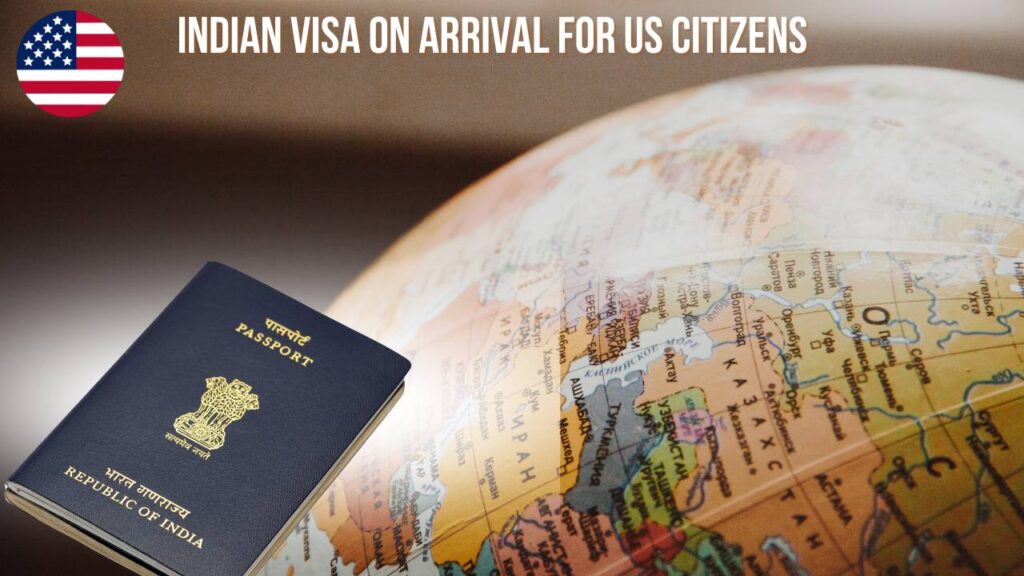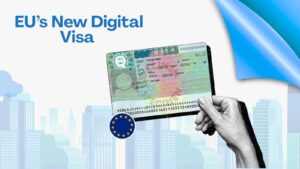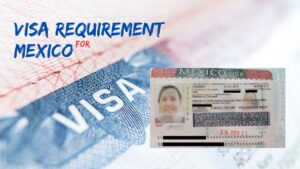If U.S. citizen planning to travel to India for tourism, business, or medical purposes, the first thing you’ll want to sort out is your visa. While many travelers search for information about the Indian visa on arrival for US citizens, it’s important to clarify that India does not provide a direct “visa on arrival” like some countries. Instead, India offers a robust and user-friendly e-Visa system that allows U.S. citizens to apply online, get approval via email, and present the visa upon arrival at immigration.
What is e-Passport? Benefits, Features & How to Apply
Here are the complete process of obtaining the Indian e-Visa, the different types available, their associated fees and validity, and everything else you need to know before flying to India. Get through every detail to ensure a smooth travel experience.
What Does “Visa on Arrival” Mean in the Indian Context?
While India doesn’t provide a literal “visa on arrival” at the airport for U.S. citizens, the Indian e-Visa system effectively serves the same purpose, offering a fast, simple, and fully online process. Instead of waiting in long lines at the airport or visiting the Indian consulate, U.S. travelers can apply from home and receive their visa via email in a few days.
Once approved, this visa must be printed out and presented at designated ports of entry in India. Immigration authorities will stamp your passport at that time. This seamless digital process is not only faster but also reduces the chances of documentation errors or last-minute surprises at the airport.
The term “visa on arrival” is often used by travelers because the e-Visa allows you to arrive in India with an already-approved document that is verified upon entry, just like a visa-on-arrival experience.
Types of Indian e-Visas for U.S. Citizens
India offers several categories of e-Visas based on the purpose of your visit. It’s essential to choose the right one to ensure you’re compliant with immigration regulations.
1. Tourist e-Visa
This is the most commonly used visa by U.S. travelers who wish to explore India’s rich culture, heritage, and natural beauty.
- 30-Day Tourist e-Visa: This visa is valid for 30 days from the date of your first entry into India. It allows double entry, meaning you can enter India two times during that period. This is best for short vacations or combined visits to neighboring countries. The fee varies by travel season — $10 for April to June and $25 for July to March.
- 1-Year Tourist e-Visa: Valid for 365 days from the date of issuance, this visa allows multiple entries, making it ideal for travelers planning to return within the year. Each stay is limited to 90 days per visit. With a fee of $40, this option offers greater flexibility for long-term explorers or those visiting family.
- 5-Year Tourist e-Visa: Perfect for frequent travelers or individuals with long-term plans in India, this visa allows multiple entries over a span of 5 years. Each stay must not exceed 90 days at a time. It comes at a cost of $80, offering the best value for regular visitors.
2. Business e-Visa
The Business e-Visa is suited for U.S. citizens visiting India for professional purposes such as attending meetings, signing contracts, trade exhibitions, or exploring partnerships.
- This visa is valid for 1 year from the date of issue, and it allows multiple entries throughout that time. Each visit can last up to 180 days, giving business travelers plenty of flexibility.
- The fee is $100, and additional documents such as an invitation letter from an Indian company and a business card must be uploaded during the application.
- It’s important to note that this visa is strictly for business and not for employment. You cannot engage in paid work or stay beyond the permitted time frame.
3. Medical e-Visa
This visa is intended for those traveling to India for medical treatments or procedures in recognized hospitals or healthcare institutions.
- It is valid for 60 days from the date of first arrival and allows triple entry, meaning you can enter India up to three times within that period. This flexibility is crucial for follow-up visits or additional medical consultations.
- The fee is $80, and a letter from the treating hospital or doctor in India must be submitted with your application.
- Patients using this visa must seek treatment only in recognized hospitals or clinics and are not allowed to engage in other activities during their stay.
Eligibility Criteria for Indian e-Visa (U.S. Citizens)
Before applying for an Indian e-Visa, it’s important to ensure that you meet all eligibility conditions set by the Indian government.
- Passport Requirements: Your U.S. passport must be valid for at least 6 months from the date of your intended arrival in India. Additionally, your passport should have at least two blank pages to accommodate entry and exit stamps.
- Intended Purpose of Travel: The reason for your travel must strictly align with the visa type. You should not engage in employment, journalism, filmmaking, or missionary work under a tourist or business e-Visa.
- Flight Details: You must possess a confirmed return ticket or onward travel ticket. Immigration officers may ask for proof of your return plans to ensure you do not intend to overstay your visa.
- Type of Passport: The e-Visa is not available for holders of diplomatic, official, or special passports. These individuals must apply through traditional visa channels at the Indian Embassy or Consulate.
- No Previous Visa Violations: Applicants who have violated visa terms or overstayed in India previously may be denied an e-Visa. Accurate and honest information during the application is mandatory.
Step-by-Step Application Process for Indian e-Visa
The Indian e-Visa process has been designed to be fully digital, straightforward, and accessible for international travelers, especially U.S. citizens. The system eliminates the need for in-person visits to an embassy and helps streamline travel preparations. Below is a complete step-by-step guide, with added details and expert tips to help you avoid common mistakes and get your visa approved smoothly.
Step 1: Visit the Official Government Website
Start by visiting the official Indian e-Visa website: https://indianvisaonline.gov.in/evisa
This is the only authorized portal to apply for the Indian e-Visa. Avoid using third-party websites or agents, as they may charge inflated service fees or, worse, result in fraudulent transactions. Always verify that the URL has “.gov.in”, which signifies an official government domain.
On the homepage, click on “Apply here for e-Visa”, and you will be directed to the application form.
Step 2: Select Your Visa Type and Begin the Application
Choose the correct visa category based on the purpose of your travel:
- Tourist e-Visa – for sightseeing, vacations, or visiting friends/family.
- Business e-Visa – for attending conferences, meetings, or business ventures.
- Medical e-Visa – for those undergoing medical treatment in India.
Fill out the application form with accurate and complete information. Even a minor mismatch with your passport details can delay or reject your application. You will need to enter:
- Your full name (exactly as it appears in your passport)
- Passport number, date of issue, and expiry date
- Date and place of birth
- Nationality and country of residence
- Planned dates of arrival and departure
- Address in India (hotel, Airbnb, or relative’s residence)
Also, make sure to select your designated port of entry from the list of e-Visa-approved airports or seaports.
Step 3: Upload Required Documents
After completing the form, you’ll be prompted to upload necessary documents. This is a crucial step—your application may be delayed or rejected if documents don’t meet the required format or clarity.
Mandatory documents for all applicants:
- A recent color passport-size photograph with a white background, face centered, and no shadows. It must be in JPEG format, ideally not exceeding 1 MB.
- A scanned copy of your passport’s bio page (PDF format, max 300 KB) clearly showing your photo, name, passport number, and other details.
Additional documents for specific visa types:
- Business Visa: Upload an invitation letter from the Indian company, detailing the purpose of your visit, along with a business card showing your designation.
- Medical Visa: Submit a letter from a recognized hospital or healthcare facility in India, specifying your treatment details and expected duration of stay.
Make sure all documents are clearly legible, as blurred or mismatched files may result in visa delays.
Step 4: Pay the Visa Fee
Once your application and documents are submitted, you’ll be directed to the payment page. Use a valid credit or debit card to pay the applicable visa fee.
The fee varies based on the type and duration of the e-Visa, ranging from $10 for a 30-day tourist visa to $100 for a business visa. An additional bank processing charge of 2.5%–3% is added to the total amount during payment.
After successful payment, you will receive a confirmation receipt with a unique Application ID number. Save this ID for tracking your visa status and future reference.
Make sure your card has international transactions enabled to avoid payment failures.
Step 5: Receive Your e-Visa by Email
Once the application is submitted and the fee is paid, the Indian authorities will begin processing your visa. For most applicants, the processing time is 3 to 5 business days, but it may take longer during peak seasons or if additional verification is required.
You will receive your approved e-Visa in PDF format via the registered email address provided in the application. It’s advisable to check your spam or junk folder in case the email is mistakenly filtered.
Once received:
- Print a hard copy of the e-Visa approval.
- Carry it with your passport when traveling.
- At the immigration desk in India, the officer will verify your e-Visa and place an official entry stamp in your passport.
Note that e-Visas are not stamped on arrival automatically—you must present the printed approval first.
Authorized Ports of Entry for e-Visa Holders
U.S. citizens using the e-Visa must enter India through approved international airports or seaports. As of 2025, there are 29 airports and 5 major seaports designated for e-Visa entry.
Major Airports Include:
- Delhi (DEL)
- Mumbai (BOM)
- Bengaluru (BLR)
- Hyderabad (HYD)
- Chennai (MAA)
- Goa (GOI)
- Ahmedabad (AMD)
- Kochi (COK)
- Kolkata (CCU)
- Jaipur (JAI)
Approved Seaports Include:
- Mumbai
- Cochin
- Goa
- Mangalore
- Chennai
You must enter through one of these ports, but you are allowed to exit from any authorized immigration checkpoint in India.
Documents Required for Indian e-Visa (For U.S. Citizens)
Before you begin your Indian e-Visa application, gather all the required documents to ensure a smooth and quick approval process. Submitting complete and accurate documentation helps avoid delays or rejections.
Mandatory Documents (Required for All Visa Types)
1. Valid U.S. Passport (with at least 6 months of validity):
- Make sure your passport remains valid for at least six months from your intended date of arrival in India.
- Ensure it includes at least two blank pages for immigration stamps.
- Avoid using emergency or temporary passports, as Indian authorities do not accept them for e-Visa applications.
2. Recent Passport-Style Photograph (Digital Format):
- Upload a clear, front-facing color photograph with a white or light background.
- Keep your face visible, remove glasses if they cause glare, and only wear head coverings for religious reasons.
- Save the photo in JPEG format with a file size under 1 MB.
3. Scanned Copy of Passport’s Biographical Page (PDF Format):
- Scan the first page of your passport that shows your full name, passport number, date of birth, and expiration date.
- Make sure the scan is clear and complete, without any cuts or blurs.
- Save the file as a PDF, and keep the size between 10 KB and 300 KB.
4. Active Email Address:
- Use an email address that you check regularly, as the system will send your e-Visa confirmation, status updates, and PDF approval there.
- Double-check the email for accuracy before submitting your application.
5. Credit or Debit Card for Online Payment:
- Use a valid international credit or debit card to pay the visa fee online.
- Make sure your card is enabled for international transactions and has sufficient balance.
Additional Documents Based on Visa Type
For Business Visa Applicants:
Letter of Invitation from the Indian Company:
- Ask the Indian company you’re visiting to provide an official letter on their letterhead.
- The letter should mention your name, purpose of visit, duration of stay, and business relationship.
- Ensure it includes the company’s stamp and an authorized signature.
Business Card or Employer Verification:
- Upload a digital copy of your business card, or a letter from your U.S.-based employer verifying your designation and reason for the trip.
- This helps Indian authorities validate your professional background and purpose of travel.
For Medical Visa Applicants:
Letter from the Recognized Indian Hospital:
- Request a letter from the hospital in India confirming your appointment and detailing the diagnosis, treatment plan, and length of stay.
- Make sure the hospital issues it on official letterhead, signed by the treating physician.
Medical Records or Appointment Confirmations (if available):
- Include supporting documents such as previous medical reports, doctor’s prescriptions, or appointment confirmations.
- These documents help establish the necessity of your medical visit to India.
Processing Time & Validity Period for Indian e-Visa (For U.S. Citizens)
Understanding the processing time and validity of each Indian e-Visa type helps you plan your trip efficiently and avoid last-minute issues. The Indian government processes most e-Visa applications quickly, but you should still apply well in advance of your travel date to avoid delays caused by verification or additional documentation requests.
Tourist e-Visa Options
30-Day Tourist e-Visa
- Validity: 30 days from the date of your first entry into India.
- Entries Allowed: Double entry permitted (you can enter India twice during this period).
- Processing Time: Indian authorities typically process this visa within 3 to 5 business days.
- Best For: Short vacations, family visits, sightseeing trips, or cultural experiences.
1-Year Tourist e-Visa
- Validity: 365 days (1 year) from the date of issue, not from the date of arrival.
- Entries Allowed: Multiple entries during the one-year period.
- Processing Time: Expect processing to take 3 to 5 business days.
- Best For: Frequent travelers, long-term visitors, or those planning multiple trips within a year.
5-Year Tourist e-Visa
- Validity: 5 years from the date of issue.
- Entries Allowed: Multiple entries allowed, with a maximum stay of 90 days per visit for most nationalities.
- Processing Time: Typically takes 3 to 5 business days.
- Best For: Regular travelers who frequently visit India for family, leisure, or spiritual reasons.
Business e-Visa
- Validity: 1 year (365 days) from the date of issue.
- Entries Allowed: Multiple entries permitted throughout the year.
- Processing Time: Usually processed within 3 to 5 business days.
- Best For: Business meetings, trade shows, sales deals, or client visits.
- Note: You must carry supporting documents such as a letter of invitation from the Indian business partner.
Medical e-Visa
- Validity: 60 days from the date of first entry into India.
- Entries Allowed: Triple entries allowed (you can enter India up to three times within the 60-day period).
- Processing Time: Processed faster than other types—typically within 2 to 4 business days.
- Best For: Individuals traveling for medical treatments, surgeries, or consultations in India.
- Note: You must submit a medical letter from a recognized Indian hospital explaining your treatment and expected duration of stay.
Important Rules & Travel Regulations for Indian e-Visa Holders (U.S. Citizens)
Traveling to India on an e-Visa requires you to follow a specific set of rules and legal obligations. The Indian government offers a convenient and efficient e-Visa system, but it comes with strict terms that every traveler must respect. Failing to follow these regulations—even unknowingly—can result in penalties, fines, or a ban from future travel. Below is a detailed explanation of the key travel rules you must follow as a U.S. citizen holding an Indian e-Visa.
1. No Extension or Conversion Permitted
The Indian e-Visa is non-extendable and non-convertible. Once the Indian government issues your e-Visa, you cannot extend its validity or switch to another visa category while in India. If your travel plans change, or your visa expires before you can complete your trip, you must submit a fresh application for a new e-Visa.
Attempting to overstay or adjust your visa while in the country is a direct violation of immigration laws and may lead to penalties. Therefore, always plan your travel dates carefully and ensure you return before your visa expires.
2. Overstaying is a Serious Offense
Even overstaying your visa by one day can lead to serious consequences in India. The Indian immigration system takes visa violations very seriously. Penalties for overstaying can include hefty fines, legal action, deportation, and even bans on re-entering the country in the future.
If you find yourself in an emergency that might cause a delay in departure, it’s important to immediately contact the nearest Foreigners Regional Registration Office (FRRO) or Indian immigration authority. It’s your responsibility to monitor your visa’s expiration date and make arrangements to leave India on or before that day.
3. Use the Visa Only for Its Intended Purpose
When applying for your e-Visa, you must choose the correct category based on your travel purpose. Each type of e-Visa—tourist, business, or medical—is issued for a specific set of activities, and you are not allowed to use it for any other reason.
For example, a tourist visa allows you to travel for leisure, sightseeing, or casual family visits but not for employment, research, or filmmaking. Similarly, a business visa permits meetings and trade events but does not authorize you to work for an Indian employer. Violating these terms, such as engaging in journalism, academic research, or paid activities on a tourist visa, is strictly prohibited and could lead to immediate cancellation of your visa.
4. Always Carry Your Documents
As an e-Visa holder, you must carry a printed copy of your approved e-Visa document along with your valid passport at all times while in India. Immigration officers, hotel staff, and airport security may ask to verify your documents during your stay.
Especially during domestic travel—by flight, train, or intercity bus—authorities may request to see your passport and visa. While keeping a digital backup on your phone or cloud storage is helpful, it does not replace the printed copy, which is often required at immigration counters and hotel check-ins.
5. Enter Only Through Designated Ports
India permits e-Visa entry only through selected international airports and seaports. As of now, over 30 airports and 5 major seaports across the country are authorized for e-Visa entry. You must ensure that your flight lands at one of these approved ports.
While you may exit the country through land border crossings or other routes, your entry must strictly occur via these designated airports or seaports. Entering through an unapproved point may result in denial of entry or deportation.
6. Respect Local Laws and Keep Emergency Contacts Handy
In addition to visa-specific rules, you should follow all local laws, customs, and cultural norms while in India. Avoid taking part in any restricted activities and maintain respectful behavior, especially at religious or public places.
Carry your flight details, accommodation confirmations, and emergency contact numbers at all times. In case of any issues such as visa-related trouble, loss of passport, or medical emergencies, you can reach out to the nearest U.S. Embassy or Consulate in India or consult local immigration officers.
FAQs
1. Does India offer a visa on arrival for U.S. citizens?
No, India does not offer a traditional visa on arrival to U.S. citizens. Instead, it offers a convenient e-Visa system, which must be applied for online before travel. Once approved, travelers can present the e-Visa at immigration upon arrival, which functions similarly to a visa on arrival.
2. What types of Indian e-Visas are available for U.S. citizens?
U.S. citizens can apply for the following e-Visa types:
- Tourist e-Visa (30 days, 1 year, or 5 years)
- Business e-Visa (valid for 1 year with 180 days per visit)
- Medical e-Visa (valid for 60 days with triple entry)
Each visa is designed for specific purposes and must be used accordingly.
3. How long does it take to get an Indian e-Visa for U.S. citizens?
The standard processing time is 3–5 business days, although in some cases it may be faster or slightly delayed during peak travel seasons. It is recommended to apply at least 7–10 days before your intended travel date to avoid last-minute issues.
4. How much does the Indian e-Visa cost for U.S. citizens?
Fees vary by visa type:
- 30-day tourist visa: $10 (Apr–Jun), $25 (Jul–Mar)
- 1-year tourist visa: $40
- 5-year tourist visa: $80
- Business visa: $100
- Medical visa: $80
A 2.5%–3% bank charge is also added at payment.
5. What documents are required for the Indian e-Visa application?
Applicants must upload:
- A clear scanned copy of the passport’s bio page (PDF format)
- A recent passport-style photograph (JPEG format)
- For business or medical visas, additional documents like an invitation letter or hospital letter are required.
6. Can I apply for an Indian e-Visa using a mobile phone or tablet?
Yes. The Indian e-Visa application portal is mobile-friendly. However, it’s recommended to use a desktop or laptop for easier document uploading and form completion. Ensure your internet connection is stable during the process.
7. How will I receive my Indian e-Visa once it’s approved?
Once your e-Visa is approved, it will be sent to your registered email address in PDF format. You must print out the e-Visa and carry it with your passport when you travel. Immigration officers will verify and stamp your entry upon arrival in India.
8. At which airports can U.S. citizens enter India with an e-Visa?
You can enter India via 29 designated international airports, including Delhi, Mumbai, Bengaluru, Chennai, Hyderabad, and Kolkata. Entry is also allowed via 5 major seaports: Mumbai, Goa, Cochin, Chennai, and Mangalore. Exit is allowed from any authorized immigration checkpoint.
9. Can I extend or convert my Indian e-Visa after arriving in India?
No. The Indian e-Visa is non-extendable and non-convertible. If your visa expires or if you need a different type of visa (e.g., work or student visa), you must leave India and apply through the appropriate channel abroad.
10. What happens if I overstay my Indian e-Visa?
Overstaying your visa is a serious offense in India. You may be fined, face deportation, or even be banned from future entry. It’s crucial to adhere to the duration specified in your visa and exit the country before your e-Visa expires.






